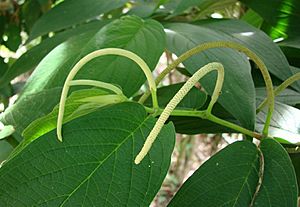Spiked pepper facts for kids
Quick facts for kids Spiked pepper |
|
|---|---|
 |
|
| Scientific classification | |
| Genus: |
Piper
|
| Species: |
aduncum
|
| Synonyms | |
|
|
Piper aduncum, also known as spiked pepper or matico, is a cool flowering plant from the Piperaceae family. This family includes the plant that gives us black pepper! Matico trees often smell a bit like pepper. You can find this plant growing wild in the forests and along the coasts of Central America and South America. It even grows high up in the mountains, sometimes as high as 3,000 meters (about 9,800 feet) above sea level.
Contents
Matico in the Kitchen
Just like other plants in its family, the matico tree has a special peppery smell. Its fruits are used as a spice to flavor food. They are also used to add taste to cocoa. Sometimes, matico is even used instead of long pepper.
Traditional Uses of Matico
In the Amazon Rainforest, many local tribes use matico leaves. They use them as an antiseptic, which helps clean wounds and stop germs. In Peru, people used matico to help stop bleeding. It was also used to help with stomach problems. In Europe, it was sometimes used for issues with the urinary organs.
Matico's Special Oil
Matico plants contain an "essential oil." This oil is made of different chemicals depending on where the plant grows. A common chemical found in it is called dillapiole. Other chemicals like myristicin and 1,8-cineole are also often present. Scientists have studied matico's essential oil. They think it could be useful as a natural way to fight insects, mites, and other tiny pests.
What Does Matico Look Like?
Matico is a tropical tree that stays green all year. It can grow quite tall, reaching about 6 to 7 meters (20 to 23 feet) high. Its leaves are shaped like a spear and are about 12 to 20 centimeters (5 to 8 inches) long. The fruit of the matico plant is small and contains black seeds.
This plant is originally from Southern Mexico, the Caribbean, and much of tropical South America. But it's also grown in tropical parts of Asia, Polynesia, and Melanesia. You can even find it in places like Florida, Hawaii, and Puerto Rico. In some areas, matico grows so well that it's considered an invasive plant. This means it can spread quickly and take over areas where it's not native. For example, in parts of New Guinea, it can make the soil dry. However, people there still use its wood for things like fuel and fence posts.
The Story Behind the Name
The name "Matico" comes from a legend. It's said that a Spanish soldier named Matico was wounded. He learned from local tribes that putting matico leaves on his wounds helped stop the bleeding. Because of this, the plant became known as "Matico" or "soldier's herb." The plant was already used by native people before Europeans arrived. In 1839, a doctor from Liverpool introduced matico to doctors in the United States and Europe. They used it to help stop bleeding and tighten tissues in wounds.
How Scientists Classify Matico
Scientists give plants special names to organize them. Piper aduncum was first described by a famous scientist named Linnaeus in 1753.
Types of Piper aduncum
There are a few slightly different types, or varieties, of Piper aduncum that scientists recognize:
- Piper aduncum var. cordulatum (C. DC.) Yunck.
- Piper aduncum var. ossanum (C. DC.) Saralegui
See also
 In Spanish: Matico para niños
In Spanish: Matico para niños

